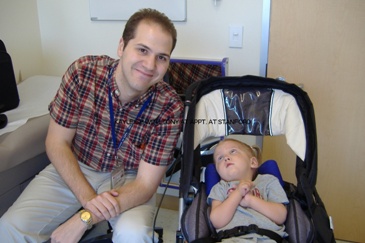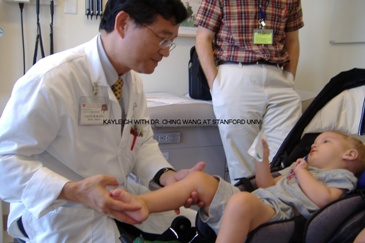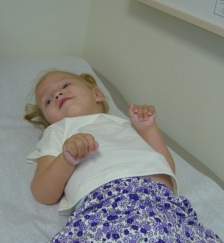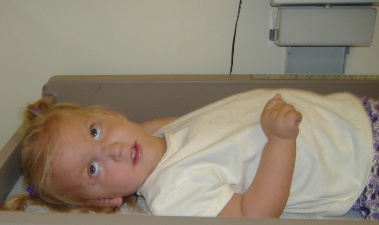 Kayleigh with Tony at Stanford |
 Kayleigh and Dr. Wang |
 |
 |
Stanford Trial
|
SMA Therapeutic Trials at Stanford University Medical Center Dr. Ching H. Wang and his colleagues at Stanford University would like to announce two therapeutic trials using hydroxyurea as a treatment for pediatric spinal muscular atrophy (SMA). The first study is targeted at children with Type I SMA and less than 2 years of age. We are looking to enroll 18 patients over the next three years for this study. The second study is targeted at patients 2 to 8 years of age with SMA of intermediate severity (those diagnosed with type II and early type III SMA). We are looking to enroll 15 patients over the next year for this study. Patients in both studies should have genetic testing confirming homozygous deletion of the SMN1 gene. The treatment period for each participating patient will be 6 months. There will be a one month observation period prior to the treatment. During this time, a monthly visit to Stanford University Medical Center is required. Several clinical and laboratory observations will be obtained during the entire study period. For more information for the SMA therapeutic trials at Stanford, please contact our study coordinator, Tony Trela, by phone at 650-498-7658 or by e-mail at sma@stanfordmed.org. Our website is http://sma.stanford.edu. Hydroxyurea enhances SMN2 gene expression in spinal muscular atrophy cells.Department of Neurology and Neurological Sciences, Stanford University Medical Center, Stanford University, Stanford, CA 94305-5235, USA. Spinal muscular atrophy (SMA) is a motor neuron disease caused by dysfunction of the survival motor neuron (SMN) gene. Human SMN gene is present in duplicated copies: SMN1 and SMN2. More than 95% of patients with SMA lack a functional SMN1 but retain at least one copy of SMN2. Unlike SMN1, SMN2 is primarily transcribed into truncated messenger RNA and produces low levels of SMN protein. We tested a therapeutic strategy by treating cultured lymphocytes from patients with SMA with hydroxyurea to modify SMN2 gene expression and to increase the production of SMN protein. Twenty lymphoblastoid cell lines (15 SMA and 5 control lines) were treated with hydroxyurea at 5 concentrations (0.5, 5, 50, 500, and 5,000 microg/ml) and 3 time points (24, 48, and 72 hours). SMN2 gene copy numbers were determined using real-time quantitative polymerase chain reaction. Hydroxyurea treatment resulted in a time-related and dose-dependent increase in the ratio of full-length to truncated SMN messenger RNA. SMN protein levels and intranuclear gems also were significantly increased in these hydroxyurea-treated cells. The SMN2 gene copy number correlated inversely with the SMA phenotypic severity. This study provides the first evidence for a therapeutic indication of hydroxyurea in SMA |